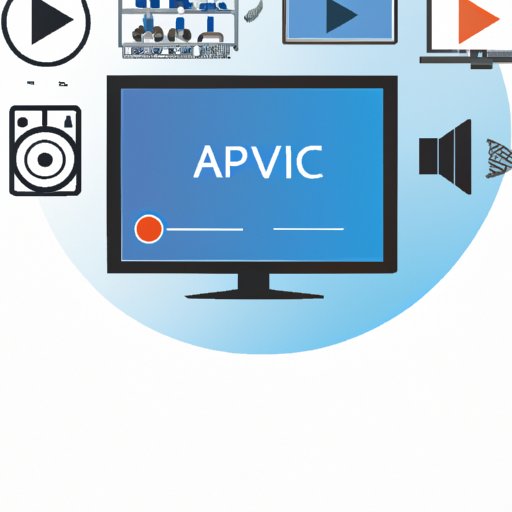Introduction
AV technology (Audio-Visual) is an umbrella term for all forms of audio-visual equipment used in modern society. It includes everything from television and home theater systems to projectors and video conferencing equipment. As technology advances, so too does the range of AV technology available, with new products being released on a regular basis.
The uses of AV technology are varied and far-reaching. It is used in entertainment, education, business, and even in the home. This article will explore the basics of AV technology and provide a comprehensive overview of its uses and benefits.

Exploring the Basics of AV Technology: A Guide for Beginners
Whether you are just starting to learn about AV technology or are looking to enhance your existing knowledge, it’s important to understand the basics. Here is a quick guide to help you get started.
What is AV Technology?
AV technology is a collection of electronic devices and software used to capture, process, and display audio and video signals. These systems can be used for a variety of applications, including home entertainment, business presentations, and educational instruction.
Types of AV Technology
AV technology includes a wide range of hardware and software. Some of the most common types include: televisions, projectors, speakers, microphones, amplifiers, cameras, computers, cables, and media players. Each of these components plays a unique role in creating a complete AV system.
Benefits of AV Technology
AV technology offers many benefits. It can improve communication and collaboration, enhance presentations and events, and increase productivity and efficiency. In addition, AV technology can provide a more engaging and immersive experience for viewers and listeners.
How AV Technology is Changing the Way We Interact with Media
AV technology is revolutionizing the way we interact with media. From streaming movies and television shows to virtual reality experiences, AV technology is transforming the entertainment industry.
The Impact of AV Technology on the Entertainment Industry
AV technology has had a profound impact on the entertainment industry. Streaming services such as Netflix and Hulu have changed the way people consume content, allowing them to watch TV shows and movies whenever and wherever they want. Virtual reality (VR) headsets are also becoming increasingly popular, allowing users to experience a completely immersive environment.
Benefits of AV Technology in Education
AV technology is also being used in education to create interactive learning experiences. For example, projectors can be used to display images and videos that can be manipulated in real time. Additionally, audio-visual systems can be used to facilitate remote learning and enable instructors to connect with students around the world.
Using AV Technology to Enhance the Home Experience
AV technology is also being used to enhance the home experience. Smart TVs allow users to access their favorite streaming services, while sound bars can provide high-quality audio. Home theaters can also be created using projectors, surround sound systems, and comfortable seating.

A Comprehensive Overview of AV Technology and Its Uses
Now that you have a better understanding of what AV technology is and its various uses, let’s take a look at some of the most common applications of AV technology.
Common Applications of AV Technology
AV technology is used in a variety of applications, including: entertainment, education, business, and home use. Entertainment applications include streaming services, home theaters, and VR headsets. Education applications include projectors, audio-visual systems, and interactive whiteboards. Business applications include video conferencing, presentation systems, and digital signage. And home applications include smart TVs, sound bars, and home theater systems.
Understanding Audio-Visual Components
In order to create a complete AV system, you must understand the different components that make up the system. The main components include: displays (televisions, projectors, monitors), audio equipment (speakers, microphones, amplifiers), video equipment (cameras, switchers, converters), and control systems (computers, cables, media players). Each component plays a vital role in creating a successful AV system.
Examples of AV Technologies
Some of the most popular examples of AV technologies include: flat panel displays, projectors, digital signage, video walls, interactive whiteboards, video conferencing systems, surround sound systems, and home theater systems.

The Benefits of Incorporating AV Technology into Your Business
AV technology can be used to improve communication and collaboration, enhance presentations and events, and increase productivity and efficiency. By incorporating AV technology into your business, you can create a more engaging and immersive experience for employees, customers, and partners.
Improving Communication & Collaboration
AV technology can be used to improve communication and collaboration between teams. Video conferencing systems allow for remote meetings and can be used to connect with clients and customers around the world. Additionally, interactive whiteboards and digital signage can be used to facilitate brainstorming sessions and share ideas in real time.
Enhancing Presentations & Events
AV technology can also be used to enhance presentations and events. Projectors and video walls can be used to create a larger-than-life presentation experience, while surround sound systems can be used to create an immersive atmosphere. Additionally, digital signage can be used to advertise products and services.
Increasing Productivity & Efficiency
AV technology can also be used to increase productivity and efficiency. Video conferencing systems can be used to reduce travel costs and eliminate the need for expensive business trips. Additionally, interactive whiteboards can be used to streamline processes and shorten training times.
How to Choose the Right AV Technology for Your Needs
When it comes to choosing the right AV technology for your needs, there are a few things to consider. First, identify your needs and budget. Research different types of AV technology to find the best solutions for your needs. Finally, make sure to find the right solution for your specific needs.
Identifying Your Needs & Budget
Before selecting AV technology, it’s important to have a clear understanding of your needs and budget. Consider the type of application you are looking to create and the size of the space you plan to use. Additionally, identify any special requirements that may be necessary, such as wireless capabilities or the ability to integrate with other systems.
Researching Different Types of AV Technology
Once you have identified your needs and budget, it’s time to start researching different types of AV technology. Read reviews, compare features, and talk to experts to get a better understanding of the options available. Additionally, research how each type of technology can be used to create the application you are looking for.
Finding the Right Solution for Your Needs
Finally, once you have identified the best solution for your needs, it’s time to find the right vendor. Look for vendors who specialize in the type of AV technology you need and who have a proven track record of success. Additionally, consider factors such as price, customer service, and warranties when making your decision.
Conclusion
AV technology is a powerful tool that can be used to create a wide range of applications. From entertainment and education to business and home use, AV technology offers many benefits. It can improve communication and collaboration, enhance presentations and events, and increase productivity and efficiency. When choosing the right AV technology for your needs, it’s important to identify your needs and budget, research different types of AV technology, and find the right solution for your specific needs.
(Note: Is this article not meeting your expectations? Do you have knowledge or insights to share? Unlock new opportunities and expand your reach by joining our authors team. Click Registration to join us and share your expertise with our readers.)
